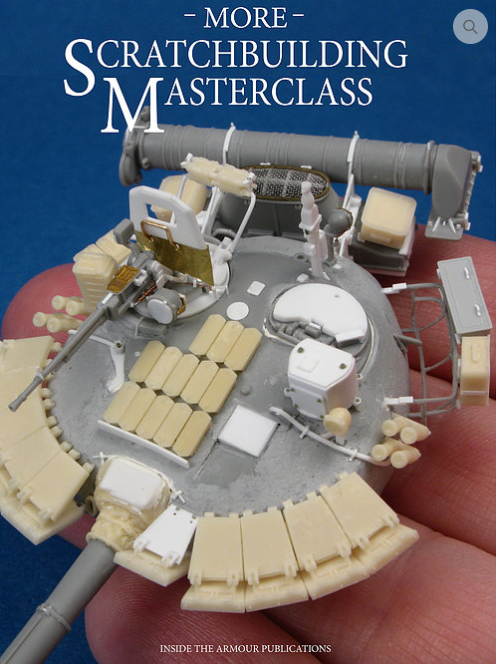 Loading... Please wait...
Loading... Please wait...“More Scratchbuilding Masterclass” - Inside the Armour Publications Review
Posted by Glen Broman on 22nd Jan 2019
“More Scratchbuilding Masterclass”
Chris Meddings, Alex Clark, Andy Canning, Darren Thompson
Published by Inside the Armour Publications
Reviewed by Glen Broman
Just when I thought it was safe to start scratchbuilding again, the folks at Inside The Armour Publications publish a new book that causes me to question both my skills and my sanity. Yes, it’s that good.
I purchased the first volume from Last Cavalry (www.lastcavalry.com) back in 2016 and was very impressed. My original review was “wow!” which as you may recall, qualified as my shortest review ever. If I were to expand on that for this review, I think I would go with “Holy crap, they did it again!”
So, before I star to wax eloquent about the content, let me take a quick diversion and tell you about the book itself. It’s a large format softcover with absolutely amazing production quality. The photos are sharp, clear and well captioned. As a result, the techniques are understandable and easy to follow. The text and photos combine to provide a product that is useful to both the novice and skilled builder. As many of you know, I’m a former tanker, so I live for pictures.
I was very happy to see that thy followed what I considered to be a strength of volume 1 in that instead of going for the bog standard build and paint format of most products on the market, they have built the structure of the book around scratchbuilding vignettes on each project, consisting of technique, text and well-illustrated step by step. The book is organized in five chapters, covering a full scratch build of a 1/350 scale ship, designing PE, an in depth case study of scratchbuilding a T-84 tank turret, an IDF detailing and conversion case study and scratchbuilding and converting WW2 German armor.
Fair warning here, if you are new to this series and have not yet read the first volume, the whole experience can be rather daunting, these folks have mad skills and as I mentioned in my volume 1 review, I required a few therapeutic beers while I resisted the urge to commit seppuku with an X-Acto knife as I read the book. I urge you to resist that outlook; once again, the purpose of the authors is not just to inspire, although that is a secondary benefit, but to explain how to approach the development of these skills in a logical manner. In his chapter on scratchbuilding the Suffren, Chris Meddings posits that scratchbuilding “is not an art…talent nor a special skill… It is rather an approach”. That is a very valuable piece of information, bringing a touch of Zen to ones modelling bench. Too many of us are overawed, and thus scared away from trying our hands at scratchbuilding or converting simply because we view it as talent or art. Looking at scratchbuilding as a means to an end makes it a much more accessible tool and allows one to view it as a process. I like that as it serves to remind that we all had to start at square one.
The first chapter covers a full scratch build of the French pre-dreadnought Suffren. Although I likely will never get around to doing a full ship scratch build, this is a very useful chapter as there are some great techniques that can be applied to detailing standard kits. There is also a useful section on doing your own PE.
Alex Clark is up next with a detailed case study of scratch building a 1/72 T-84 tank turret. This is an absolutely amazing build, especially when you consider that many of the pieces pictured are using the tip of the author’s finger as a backdrop. Based on my own experiences with small parts on my braille scale builds, I can’t help but wonder how many of these parts fed his carpet monster at one time or another. Again, there are some very useful techniques described here.
Andy Canning’s chapter covers converting a Dragon M3 Halftrack to an Israeli 90mm gunned version. This is a good primer in converting a kit you have into a kit you don’t. This is right in my wheel house as those are the majority of projects I’ve done over the years, rather than full scratch builds.
The last chapter is by Darren Thompson and covers scratchbuilding and converting WWII German armor. This chapter is different in that it doesn’t concentrate on just one build but is more conceptual in nature as it covers the full process of building and converting in a logical process illustrated with a few different projects and a nice gallery of finished projects at the end. If you are wondering how to lay out a project from beginning to end, this will be a handy piece of kit.
I received my copy from Dave Youngquist at www.lastcavalry.com.

